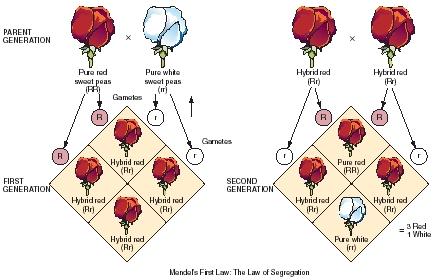Mendelian laws of inheritance

Mendelian laws of inheritance are statements about the way certain characteristics are transmitted from one generation to another in an organism. The laws were derived by the Austrian monk Gregor Mendel (1822–1884) based on experiments he conducted in the period from about 1857 to 1865. For his experiments, Mendel used ordinary pea plants. Among the traits that Mendel studied were the color of a plant's flowers, their location on the plant, the shape and color of pea pods, the shape and color of seeds, and the length of plant stems.
Mendel's approach was to transfer pollen (which contains male sex cells) from the stamen (the male reproductive organ) of one pea plant to the pistil (female reproductive organ) of a second pea plant. As a simple example of this kind of experiment, suppose that one takes pollen from a pea plant with red flowers and uses it to fertilize a pea plant with white flowers. What Mendel wanted to know is what color the flowers would be in the offspring of these two plants. In a second series of experiments, Mendel studied the changes that occurred in the second generation. That is, suppose two offspring of the red/white mating ("cross") are themselves mated. What color will the flowers be in this second generation of plants? As a result of these experiments, Mendel was able to state three generalizations about the way characteristics are transmitted from one generation to the next in pea plants.
Words to Know
Allele: One of two or more forms a gene may take.
Dominant: An allele whose expression overpowers the effect of a second form of the same gene.
Gamete: A reproductive cell.
Heterozygous: A condition in which two alleles for a given gene are different from each other.
Homozygous: A condition in which two alleles for a given gene are the same.
Recessive: An allele whose effects are concealed in offspring by the dominant allele in the pair.
Terminology
Before reviewing these three laws, it will be helpful to define some of the terms used in talking about Mendel's laws of inheritance. Most of these terms were invented not by Mendel, but by biologists some years after his research was originally published.
Genes are the units in which characteristics are passed from one generation to the next. For example, a plant with red flowers must carry a gene for that characteristic.
A gene for any given characteristic may occur in one of two forms, called the alleles (pronounced uh-LEELZ) of that gene. For example, the gene for color in pea plants can occur in the form (allele) for a white flower or in the form (allele) for a red color.
The first step that takes place in reproduction is for the sex cells in plants to divide into two halves, called gametes. The next step is for the gametes from the male plant to combine with the gametes of the female plant to produce a fertilized egg. That fertilized egg is called a zygote. A zygote contains genetic information from both parents.
For example, a zygote might contain one allele for white flowers and one allele for red flowers. The plant that develops from that zygote would said to be heterozygous for that trait since its gene for flower color has two different alleles. If the zygote contains a gene with two identical alleles, it is said to be homozygous.

Mendel's laws
Mendel's law of segregation describes what happens to the alleles that make up a gene during formation of gametes. For example, suppose that a pea plant contains a gene for flower color in which both alleles code for red. One way to represent that condition is to write RR, which indicates that both alleles (R and R) code for the color red. Another gene might have a different combination of alleles, as in Rr. In this case, the symbol R stands for red color and the r for "not red" or, in this case, white. Mendel's law of segregation says that the alleles that make up a gene separate from each other, or segregate, during the formation of gametes. That fact can be represented by simple equations, such as:
RR → R + R or Rr → R + r
Mendel's second law is called the law of independent assortment. That law refers to the fact that any plant contains many different kinds of genes. One gene determines flower color, a second gene determines length of stem, a third gene determines shape of pea pods, and so on. Mendel discovered that the way in which alleles from different genes separate and then recombine is unconnected to other genes. That is, suppose that a plant contains genes for color (RR) and for shape of pod (TT). Then Mendel's second law says that the two genes will segregate independently, as:
RR → R + R and TT → T + T
Mendel's third law deals with the matter of dominance. Suppose that a gene contains an allele for red color (R) and an allele for white color (r). What will be the color of the flowers produced on this plant? Mendel's answer was that in every pair of alleles, one is more likely to be expressed than the other. In other words, one allele is dominant and the other allele is recessive. In the example of an Rr gene, the flowers produced will be red because the allele R is dominant over the allele r.
Predicting traits
The application of Mendel's three laws makes it possible to predict the characteristics of offspring produced by parents of known genetic composition. The picture on page 1248, for example, shows the cross between a sweet pea plant with red flowers (RR) and one with white flowers (rr). Notice that the genes from the two parents will segregate to produce the corresponding alleles:
RR → R + R and rr → r + r
There are, then, four ways in which those alleles can recombine, as shown in the same picture. However, all four combinations produce the same result: R + r → Rr. In every case, the gene formed will consist of an allele for red (R) and an allele for "not red" (r).
The drawing at the right in the picture on page 1248 shows what happens when two plants from the first generation are crossed with each other. Again, the alleles of each plant separate from each other:
Rr → R + r
Again, the alleles can recombine in four ways. In this case, however, the results are different from those in the first generation. The possible results of these combinations are two Rr combinations, one RR combination, and one rr combination. Since R is dominant over r, three of the four combinations will produce plants with red flowers and one (the rr option) will product plants with non-red (white) flowers.
Biologists have discovered that Mendel's laws are simplifications of processes that are sometimes much more complex than the examples given here. However, those laws still form an important foundation for the science of genetics.
[ See also Chromosome ; Genetics ]
hope you can help me...
I have another question too. I have never used this site. I dont know if you can ask two questions.
But my other ? is: A recessive allele t is responsible for a condition called distonia. A man who has this condition marries a woman who doesn't. One of their 4 children has a condition. What are the possible genotypes of the man and the woman?
PLEASE HELP!
I have question that why in some cases there are in complete
dominane.
I understand brown is dominant.
Please tell me if you know
THANKS sir
Feels as if mendel himself was explaining
can help genetics students allover the world